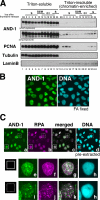Roles of human AND-1 in chromosome transactions in S phase
- PMID: 19439411
- PMCID: PMC2742837
- DOI: 10.1074/jbc.M806711200
Roles of human AND-1 in chromosome transactions in S phase
Abstract
Coordinated execution of DNA replication, checkpoint activation, and postreplicative chromatid cohesion is intimately related to the replication fork machinery. Human AND-1/chromosome transmission fidelity 4 is localized adjacent to replication foci and is required for efficient DNA synthesis. In S phase, AND-1 is phosphorylated in response to replication arrest in a manner dependent on checkpoint kinase, ataxia telangiectasia-mutated, ataxia telangiectasia-mutated and Rad3-related protein, and Cdc7 kinase but not on Chk1. Depletion of AND-1 increases DNA damage, delays progression of S phase, leads to accumulation of late S and/or G2 phase cells, and induces cell death in cancer cells. It also elevated UV-radioresistant DNA synthesis and caused premature recovery of replication after hydroxyurea arrest, indicating that lack of AND-1 compromises checkpoint activation. This may be partly due to the decreased levels of Chk1 protein in AND-1-depleted cells. Furthermore, AND-1 interacts with cohesin proteins Smc1, Smc3, and Rad21/Scc1, consistent with proposed roles of yeast counterparts of AND-1 in sister chromatid cohesion. Depletion of AND-1 leads to significant inhibition of homologous recombination repair of an I-SceI-driven double strand break. Based on these data, we propose that AND-1 coordinates multiple cellular events in S phase and G2 phase, such as DNA replication, checkpoint activation, sister chromatid cohesion, and DNA damage repair, thus playing a pivotal role in maintenance of genome integrity.
Figures





Similar articles
-
Involvement of the cohesin protein, Smc1, in Atm-dependent and independent responses to DNA damage.Genes Dev. 2002 Mar 1;16(5):560-70. doi: 10.1101/gad.970602. Genes Dev. 2002. PMID: 11877376 Free PMC article.
-
Cohesin promotes the repair of ionizing radiation-induced DNA double-strand breaks in replicated chromatin.Nucleic Acids Res. 2010 Jan;38(2):477-87. doi: 10.1093/nar/gkp976. Epub 2009 Nov 11. Nucleic Acids Res. 2010. PMID: 19906707 Free PMC article.
-
Human Rad9 is required for the activation of S-phase checkpoint and the maintenance of chromosomal stability.Genes Cells. 2005 Apr;10(4):287-95. doi: 10.1111/j.1365-2443.2005.00840.x. Genes Cells. 2005. PMID: 15773892
-
An imperfect G2M checkpoint contributes to chromosome instability following irradiation of S and G2 phase cells.Cell Cycle. 2007 Jul 15;6(14):1682-6. doi: 10.4161/cc.6.14.4480. Epub 2007 May 21. Cell Cycle. 2007. PMID: 17637566 Review.
-
Cohesin in DNA damage response and double-strand break repair.Crit Rev Biochem Mol Biol. 2022 Jun;57(3):333-350. doi: 10.1080/10409238.2022.2027336. Epub 2022 Feb 3. Crit Rev Biochem Mol Biol. 2022. PMID: 35112600 Review.
Cited by
-
Phosphorylated Rad18 directs DNA polymerase η to sites of stalled replication.J Cell Biol. 2010 Nov 29;191(5):953-66. doi: 10.1083/jcb.201006043. Epub 2010 Nov 22. J Cell Biol. 2010. PMID: 21098111 Free PMC article.
-
ZBTB16 inhibits DNA replication and induces cell cycle arrest by targeting WDHD1 transcription in lung adenocarcinoma.Oncogene. 2024 Jun;43(23):1796-1810. doi: 10.1038/s41388-024-03041-0. Epub 2024 Apr 23. Oncogene. 2024. PMID: 38654107
-
Role of WDHD1 in Human Papillomavirus-Mediated Oncogenesis Identified by Transcriptional Profiling of E7-Expressing Cells.J Virol. 2016 Jun 10;90(13):6071-6084. doi: 10.1128/JVI.00513-16. Print 2016 Jul 1. J Virol. 2016. PMID: 27099318 Free PMC article.
-
The involvement of acidic nucleoplasmic DNA-binding protein (And-1) in the regulation of prereplicative complex (pre-RC) assembly in human cells.J Biol Chem. 2012 Dec 14;287(51):42469-79. doi: 10.1074/jbc.M112.404277. Epub 2012 Oct 23. J Biol Chem. 2012. PMID: 23093411 Free PMC article.
-
Replication-compromised cells require the mitotic checkpoint to prevent tetraploidization.Chromosoma. 2011 Feb;120(1):73-82. doi: 10.1007/s00412-010-0292-7. Epub 2010 Sep 9. Chromosoma. 2011. PMID: 20827484
References
-
- Zou L., Stillman B. (1998) Science 280, 593–596 - PubMed
-
- Masai H., Taniyama C., Ogino K., Matsui E., Kakusho N., Matsumoto S., Kim J. M., Ishii A., Tanaka T., Kobayashi T., Tamai K., Ohtani K., Arai K. (2006) J. Biol. Chem. 281, 39249–39261 - PubMed
-
- Tanaka S., Umemori T., Hirai K., Muramatsu S., Kamimura Y., Araki H. (2007) Nature 445, 328–332 - PubMed
Publication types
MeSH terms
Substances
LinkOut - more resources
Full Text Sources
Molecular Biology Databases
Research Materials
Miscellaneous

